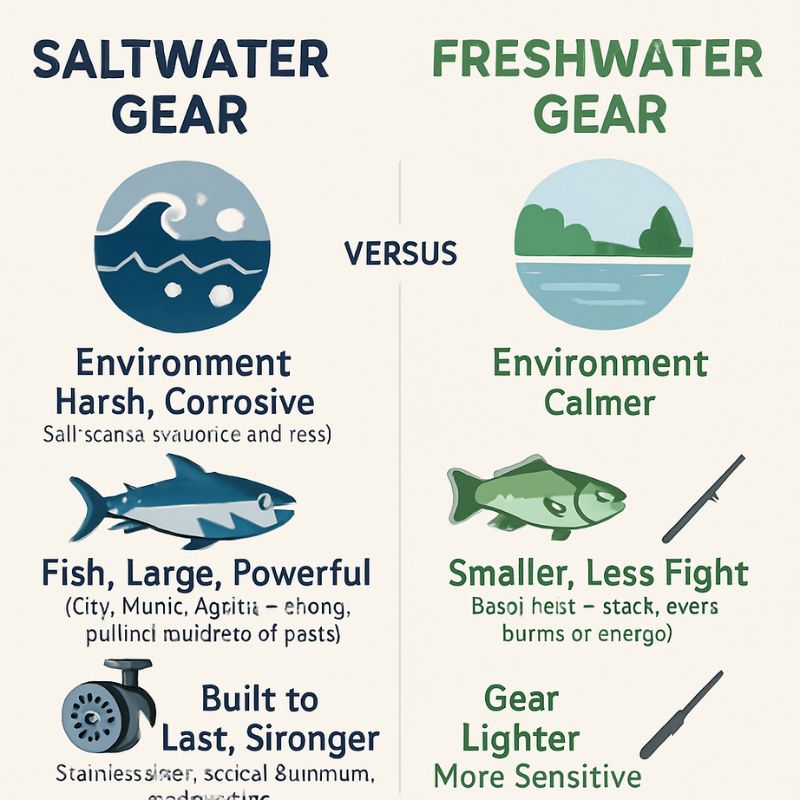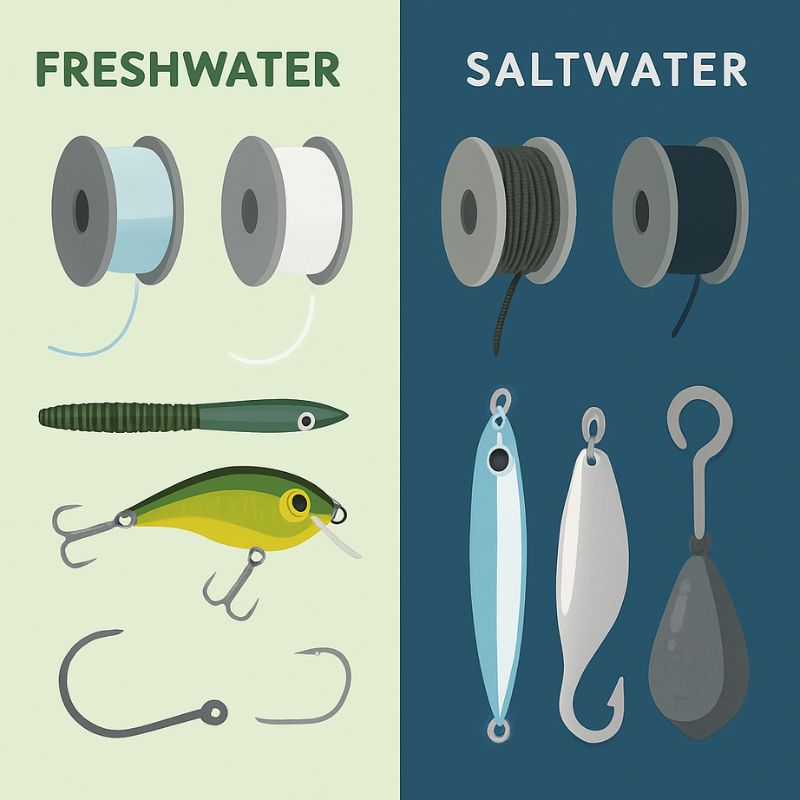Choosing the Right Gear: Saltwater vs. Freshwater Rods & Reels
As an angler, have you ever wondered if you can use the same fishing gear for both a lake and the ocean? It’s a common question, and the simple answer is no. While you can certainly make it work for a short trip, using Freshwater gear in saltwater is a recipe for disaster. The difference between saltwater and freshwater fishing gear is bigger than you might think. Choosing the right equipment is a key step to being a successful angler. The fishing environment and the kind of fish you are targeting play a big role in the type of rod and reel you need. This article will help you understand what makes each type of gear unique and why it matters for your next fishing adventure.
To learn more about the basic differences in fishing environments, you can also check out this article on freshwater vs. saltwater fishing.
The Core Differences: Why Saltwater and Freshwater Gear Are Not the Same
Let’s start with the basics. The main reason Saltwater and Freshwater fishing gear are different comes down to two things: the environment and the size of the fish you’re after. Saltwater is harsh and corrosive, which means the gear has to be built to last. Freshwater, on the other hand, is a much calmer environment, so the gear can be lighter and more sensitive.

The Role of Environment in Gear Selection
Think of it like this: your car is great for driving on city streets, but you wouldn’t use it for a race on a dirt track. The same idea applies here.
Saltwater’s Corrosive Nature
The biggest enemy of Saltwater fishing gear is the salt itself. Sodium chloride in saltwater causes a chemical reaction with metal that leads to Corrosion and rust. This can ruin your reel, guides, and other components in just a few trips if they aren’t made from corrosion-resistant materials. That’s why Saltwater fishing gear is made with special materials like stainless steel and coated aluminum. If you leave leftover salt on your gear, even these tough materials can start to break down.
The Fish: Size, Strength, and Fight
The kind of fish you are trying to catch also changes what kind of gear you need.
- Freshwater: Most freshwater fish, like bass and trout, are smaller and don’t fight as hard as their ocean cousins. They are known for quick, short bursts of energy, which means you need a fishing rod that is light and sensitive so you can feel the smallest bite.
- Saltwater: In the ocean, you might be after big tuna, marlin, or even sharks. These fish are powerful and can pull a line for hundreds of yards. This calls for Saltwater rods and reels that are much stronger and have a lot more Power to handle the pressure.
Characteristics of Freshwater Fishing Gear: Finesse and Precision
When you’re fishing in a freshwater reservoir, a river, or a lake, the goal is often to be sneaky and precise. Freshwater fishing is all about a delicate touch.

Rod and Reel Design for Freshwater Fishing
Freshwater rods and reels are designed to be light so you can cast accurately and feel everything that happens at the end of your line.
Finesse and Precision Needs
Freshwater rod manufacturers usually make rods from graphite or a blend of Carbon to make them lightweight and sensitive. This lets you feel a light tap from a fish on your bait or Lures. The rod also needs to be flexible enough to absorb a fish’s movements without breaking the line. The guides on a freshwater rod are typically smaller and lighter.
Material Choices for Freshwater Rods and Reels
Freshwater rod components and reels are not designed to fight off Corrosion as much as Saltwater gear. They are often made from aluminum or plastic, which are lighter but not built to handle the salt. The drag system on a freshwater reel is usually smaller since it won’t need to slow down a massive fish.
Freshwater Line and Tackle Specifications
The type of line you use for freshwater fishing also plays a big role in your success.
Freshwater Line and Terminal Tackle
Most freshwater anglers use monofilament line or fluorocarbon line. These lines are almost invisible in the water. The terminal tackle, which includes hooks and Lures, is much smaller and lighter. For example, a popular type of lure for bass is a senko, which is a plastic worm. Often, people fish with lightly weighted t-rig senkos to get a very natural movement in the water.
Characteristics of Saltwater Fishing Gear: Durability and Corrosion Resistance
Saltwater fishing is a different beast. It’s a battle against the elements and strong fish. Your gear needs to be a robust tool, not a delicate instrument.

Durability and Corrosion Resistance
Saltwater fishing gear is built to last. It’s tough and can handle a lot of wear and tear.
Material Choices for Saltwater Rods and Reels
Saltwater rods are often made from a mix of graphite and fiberglass, which gives them more Power and strength to handle big fish. The guides on Saltwater rods are larger and more durable, often made with Titanium or high-quality stainless steel to resist rust. The Reel seats are also thicker and tougher.
Strength and Power for Ocean Species
Saltwater reels are designed to be fully sealed, so no salt or sand can get in. The drag system is bigger and stronger. It often uses washers made of carbon fiber or other strong materials. These washers help slow down a fast-running fish. Many Saltwater anglers use big reels mounted on a boat for deep-sea fishing or smaller, but still strong, reels for inshore fishing from the shore.
Saltwater Line and Terminal Tackle
The line and tackle for Saltwater fishing need to be as strong as the rod and reel.
Saltwater Line and Terminal Tackle
Saltwater anglers often use a braided line because it is incredibly strong for its size and doesn’t stretch. This gives you more Power to pull in a large fish. The terminal tackle is also much bigger. You’ll find heavy-duty hooks, large metal Lures, and heavy sinkers designed to get your bait down deep in the ocean.
Comparing Saltwater and Freshwater Fishing Rods and Reels
Let’s look at the main differences side-by-side. This will help you see why one type of gear won’t work well for the other.
| Feature | Freshwater Fishing Gear | Saltwater Fishing Gear |
|---|---|---|
| Rod Materials | Graphite, lightweight | Fiberglass/graphite composite, strong |
| Reel Design | Lighter, less sealed | Heavier, fully sealed |
| Drag System | Smaller, less powerful | Larger, more powerful |
| Guides | Small, delicate | Large, corrosion-resistant (stainless steel, Titanium) |
| Line | Monofilament, fluorocarbon | Braided lines, heavy monofilament |
| Durability | Sensitive, not rust-proof | Strong, built to fight Corrosion |
Performance Expectations
- Freshwater: Expect your gear to be light and sensitive. You should be able to feel a small fish taking your bait or a subtle change in the current.
- Saltwater: Expect your gear to be a workhorse. It won’t have the same level of feel, but it will have the strength to handle big fish and the constant stress of the ocean.
Maintenance Needs for Longevity
Taking care of your fishing gear is important, but it’s extra important for Saltwater gear.
- Freshwater gear: A simple wipe-down and occasional oiling is usually enough.
- Saltwater gear: After every single trip, you need to rinse your equipment with fresh water to remove any leftover salt. If you don’t, Corrosion will start almost immediately.
Fishing Line and Terminal Tackle Differences
Don’t forget about the small parts! The line and tackle you use are just as important as the rod and reel.

Line Strength and Composition
- Freshwater: Monofilament line is a great all-around choice. It stretches a bit and is easy to handle. Fluorocarbon line is also popular because it’s nearly invisible underwater and sinks quickly. A lot of anglers like a braided line for freshwater for its sensitivity. For instance, fishing omen green is a popular color.
- Saltwater: Braided lines are the go-to for Saltwater fishing because of their strength and lack of stretch. You can use a thinner line that can hold a lot of Power, which is important for a large fish.
Terminal Tackle: Hooks, Lures, and Weights
The terminal tackle you use must match the type of fishing you are doing.
- Freshwater: Lures are often smaller and more colorful to mimic bugs or smaller fish. Senkos and other soft plastic Lures are very popular. Hooks are smaller and lighter.
- Saltwater: Hooks are much larger, stronger, and built to handle big fish. Lures are often metal, heavy, and designed to look like larger bait fish.
Final Thoughts on Matching Your Gear to Your Fishing Environment
Choosing the right fishing gear is not a small detail; it’s a key part of your success. Just like a carpenter wouldn’t use a screwdriver to hammer a nail, a smart angler doesn’t use freshwater fishing gear for Saltwater fishing. You need strong and rust-resistant saltwater gear for the ocean. You also need sensitive and delicate freshwater gear for lakes and rivers. You can understand the difference between freshwater rods and saltwater rods. You can also learn about the parts that go with them. This helps you prepare your fishing rods and reel collection for any challenge.
Conclusion
By understanding the key differences in materials, design, and maintenance, you can feel confident in your gear choices. Having the right fishing equipment for the right water will not only make you a better angler but will also make your gear last much longer. Whether you’re planning an inshore fishing trip or a quiet day at a freshwater reservoir, having the right tools for the job is the most important step to a great day on the water.
FAQs
1. Can I use a saltwater rod for freshwater fishing?
Yes, you can, but it is not ideal. A saltwater rod is heavier and less sensitive, which makes it harder to feel the subtle bites of a small freshwater fish. It also puts a lot of extra weight on one’s shoulders.
2. What happens if I use my freshwater reel in saltwater?
The sodium chloride in the water will start to cause Corrosion on the metal components of your reel. The bearings can seize up, and the drag system may fail. This will likely ruin your reel in just a few Saltwater fishing trips.
3. What is the difference between braided lines and monofilament lines?
Braided lines are much stronger and have no stretch, which gives you more Power and sensitivity. Monofilament line is cheaper and has some stretch, which is good for shock absorption, but it’s not as strong as a braided line of the same diameter.
4. How do I protect my gear from saltwater corrosion?
After every Saltwater fishing trip, you should rinse all of your gear—rods, reels, and Lures—with fresh water. Pay special attention to the reel to remove any leftover salt.
5. Is there such a thing as a universal fishing rod?
Some rod manufacturers make multipurpose rods that can be used in both environments, but they are often a compromise. These types of rods are usually made with corrosion-resistant materials, but they lack the finesse of a true freshwater rod and the Power of a true Saltwater rod.
6. What’s the main difference between freshwater rod components and saltwater rod components?
The biggest difference between freshwater and saltwater rod components is the materials. Saltwater components are made from more durable, rust-proof materials like stainless steel and Titanium, while freshwater rod components are lighter and less resistant to rust.
7. Why do saltwater reels have a larger drag system?
Saltwater fish are much bigger and stronger. A larger drag system is needed to slow down a big fish that is trying to swim away without the line snapping.

